The traditional action for New Year’s Eve is to go to a party, stay up until midnight and watch the bell drop, and the traditional song is Auld Lang Syne.
I’ve stopped doing any of these things.
My traditional action is now to watch a bunch of great college football games that are the cumulation of the year’s season, and maybe have a few friends over.
As for songs, I have two. First, to look back on the year and the ways one is stuck, and think about and motivate what one might change, Anastasia’s Same Old Story. Then, to remind that life is awesome and my life is awesome, Jewel’s This Way.
It’s important to have rituals and traditions that speak to you.
It’s also important to contain multitudes.
The darkness is coming. So is the light.
Life is good. All signs point towards the golden scenario of a quick peak under reduced severity.
Happy new year!
Around the World
South Africa, the UK and Denmark are no longer uniquely informative places, so I’m combining all the areas into one section now.
There are a few cities where we may have peaked, but otherwise outside of South Africa? Not so much.
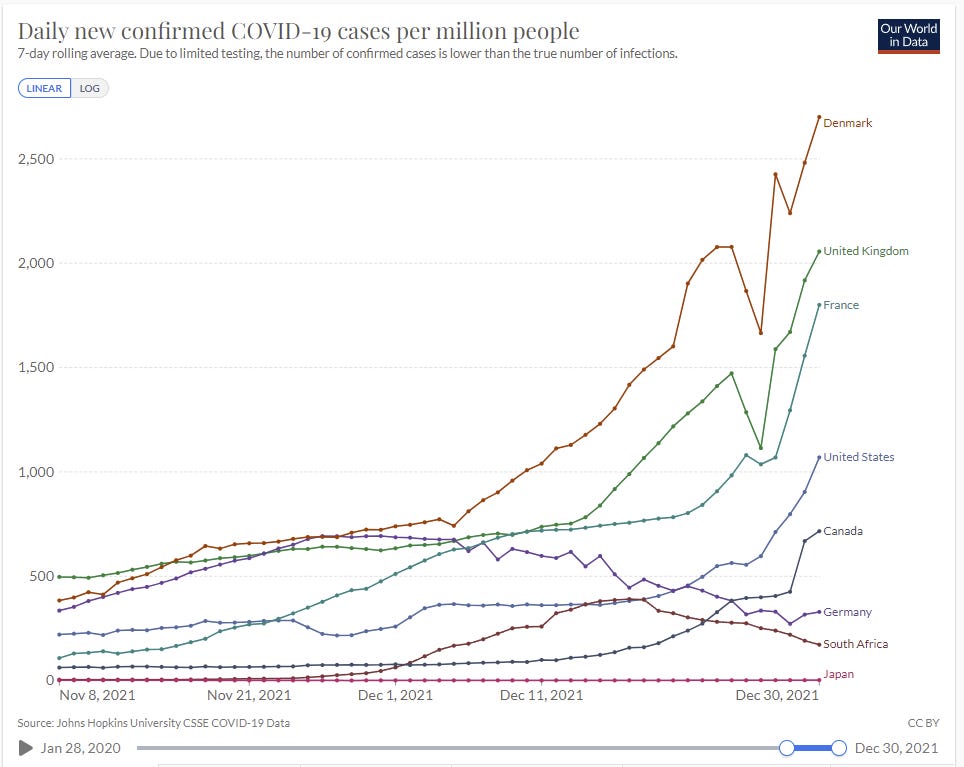
Cases still growing in the UK, but perhaps no longer growing in London.
Here’s a UK hospital update, from the comments via MoveMyCat:
I work at a large teaching hospital in the UK, but outside London. I’ve been isolating for a while (very mild if any symptoms, but was undergoing regular testing at work). Prior to my isolation, there were rising numbers, but they were still using respiratory beds for ‘Incidental Covid’ types. Anecdotal observation supported the idea that staff isolation and the need to isolate from vulnerable Covid-negatives was more of a challenge at that point than any influx of very unwell Covid pneumonitis types.
I’ll aim to update when I’m next in work.
…
I’m back in work now. There’s a small uptick in actual respiratory admissions but most of the increased Covid capacity the hospital has put together is being filled by geriatrics patients who happen to have Covid. A friend who works at a nearby hospital reports that she has about a quarter of her unit in self isolation for one reason or other.
It’s actually remarkable how few people are coming in with fevers and breathlessness.
If we do have access to the numbers on any of that, please do share, for now I only know of such numbers in San Francisco.
Germany is behind other countries in terms of spread and has stalled for time, but it won’t be that much time, and it will change very little. That last week in gray isn’t fully reported yet, so this is the same old story as everywhere else.

In hindsight, that first Boston wastewater jump was probably Delta. The one now, not so much:
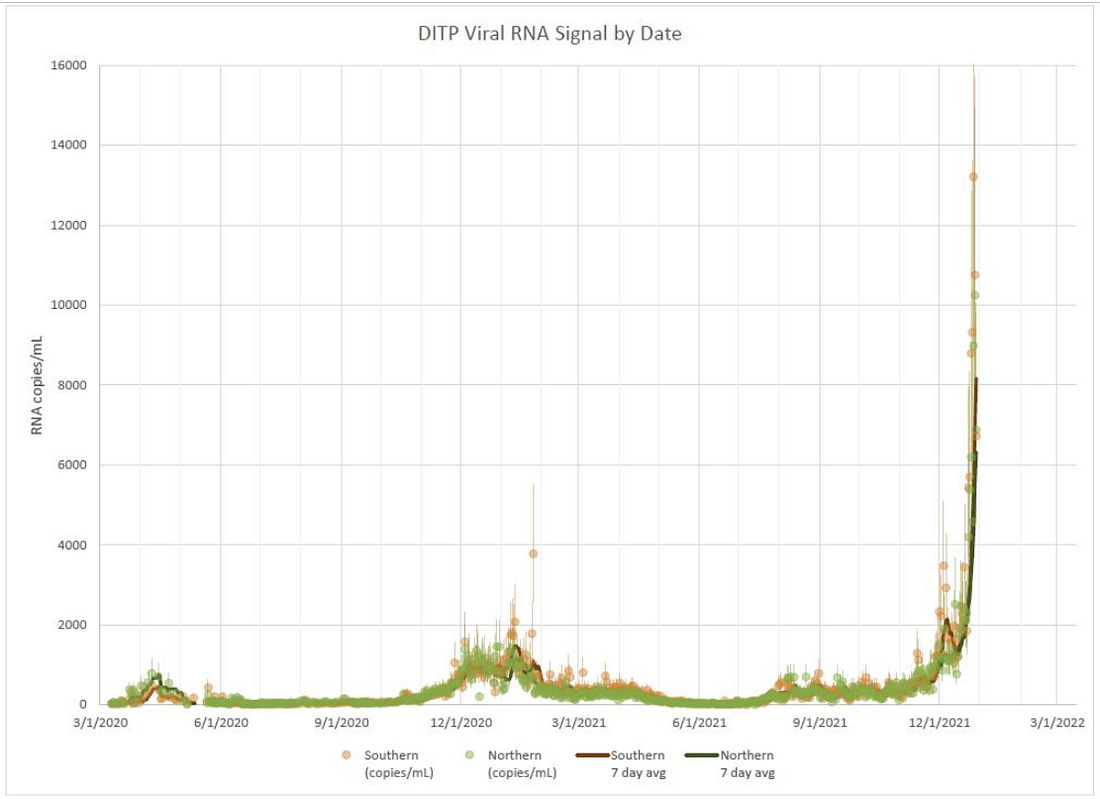
If we use the black line, the average is now over four times the previous maximum level. If we use the recent data points as an indication, there’s at least one more doubling after that.
An update from San Francisco, where the ‘with Covid’ and ‘for Covid’ distinction is actually being measured (and I’m happy that Dr. Fauci has ‘broken the seal’ and is talking about the distinction in earnest.)

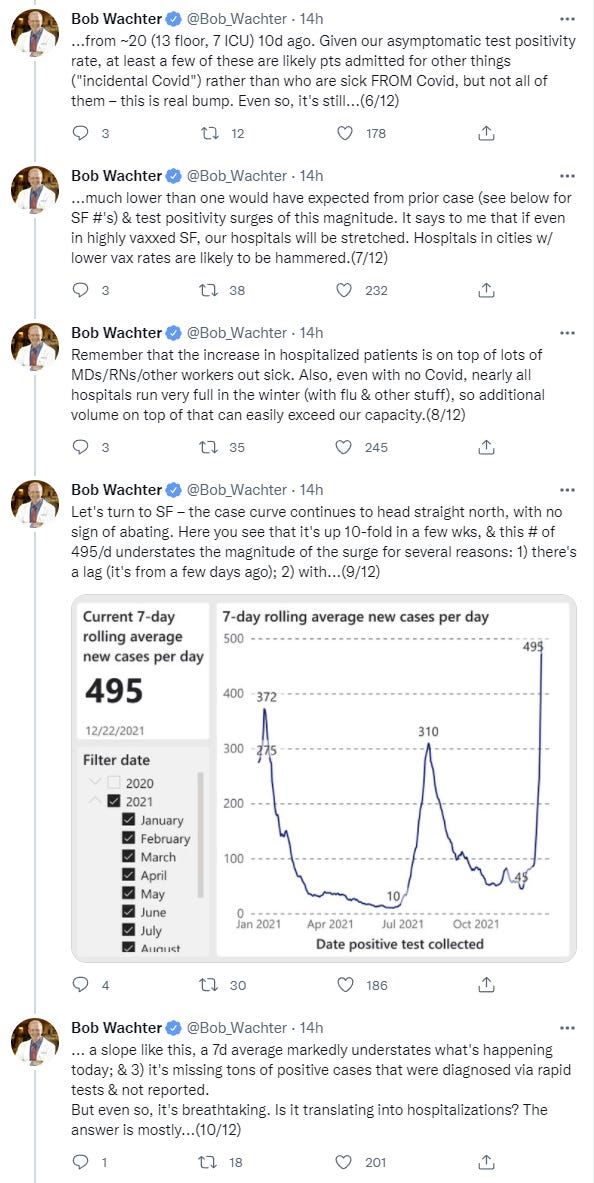
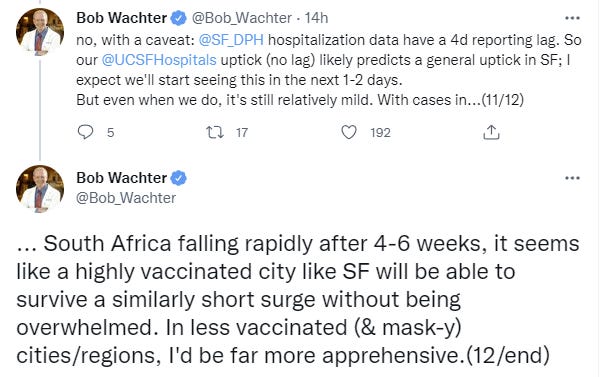
This seems roughly right to me. If you have a highly vaccinated population and solid hospital capacity, even with this rapid a storm, we should mostly be able to muddle through, things can only add to 100% (and presumably cap out at more like a total of 80%-90%). If the peak is as high in rural areas with less beds and less vaccinations, I’d be a lot more nervous.
Note that San Francisco’s positive rate is somewhat lower than the national average, so it’s probably missing a slightly lower percentage of its cases than other places.
21% of the NYPD was out sick Thursday in what outgoing Police Commissioner Dermot Shea said was the highest level of sick employees he had ever seen. 17% were out a day earlier.
“When you look at March 2020 we peaked at 19.8%, we hit 21% today,” said Shea during a briefing on security for New Year’s Eve festivities in Times Square.
30% of EMS and 17% FDNY were on medical leave.
That can’t go on for that long, because math.
Forgot to include it in the weekly post, but the daily positive rate in the USA is another good measure.
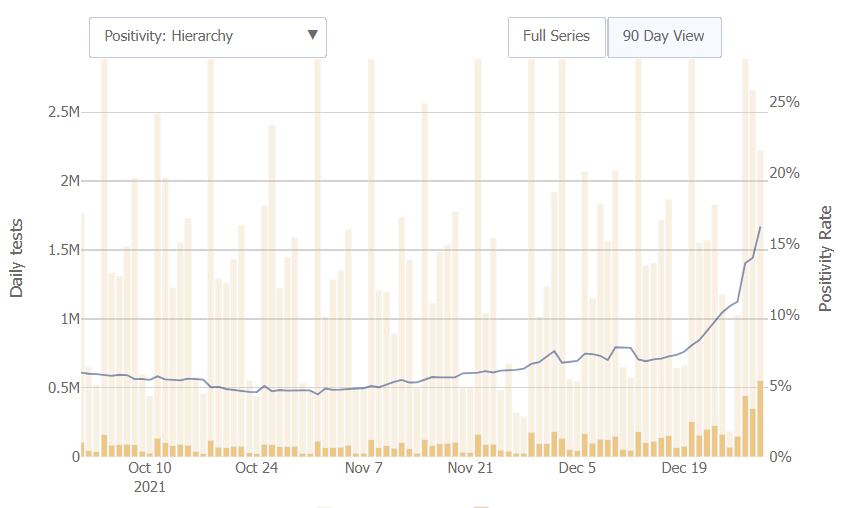
I still don’t know how to properly translate a 16% positive rate into an expected percentage of cases being missed, but this will likely be the best way to tell now whether things have actually peaked or not. We previously peaked at around 23% on this chart early in the pandemic, with 50%+ rates in New York City, on vastly less testing.
Vaccine Effectiveness
A commenter on the last post notes that in Canada, while measured vaccine effectiveness in preventing infections dropped to zero or below (I continue to think this is a rural/urban effect in large part), against hospitalization it’s still strong. Graham thinks the essential story is that vaccine protection against severe outcomes is holding but doesn’t believe that Omicron is much less virulent than Delta (to continue to note that opinions on this differ.)
Using Alberta, Canada numbers. The current rate of those hospitalized who were vaccinated is 3.68/100k, and among the unvaccinated it is 20.17/100k. On December 4 it was vaccinated 3.84/100k and unvaccinated 26.69/100k. Since the rise of Omicron, the rate of hospitalizations has actually gone down in both populations, but the vaccinated now have a slightly higher relative rate of hospitalization than they did pre-Omicron. (Vaccinated rate was 14.4% that of the unvaccinated rate 3 weeks ago, and now it is closer to 18.2%.)
Two shots of J&J in South Africa gave 85% protection against hospitalization. The first shot alone gave 63%, so the second shot was an additional 50% from there.
T-Cells from vaccination still holding up well. Looking good.
It’s still a pandemic of the unvaccinated when it comes to hospitalization and death.

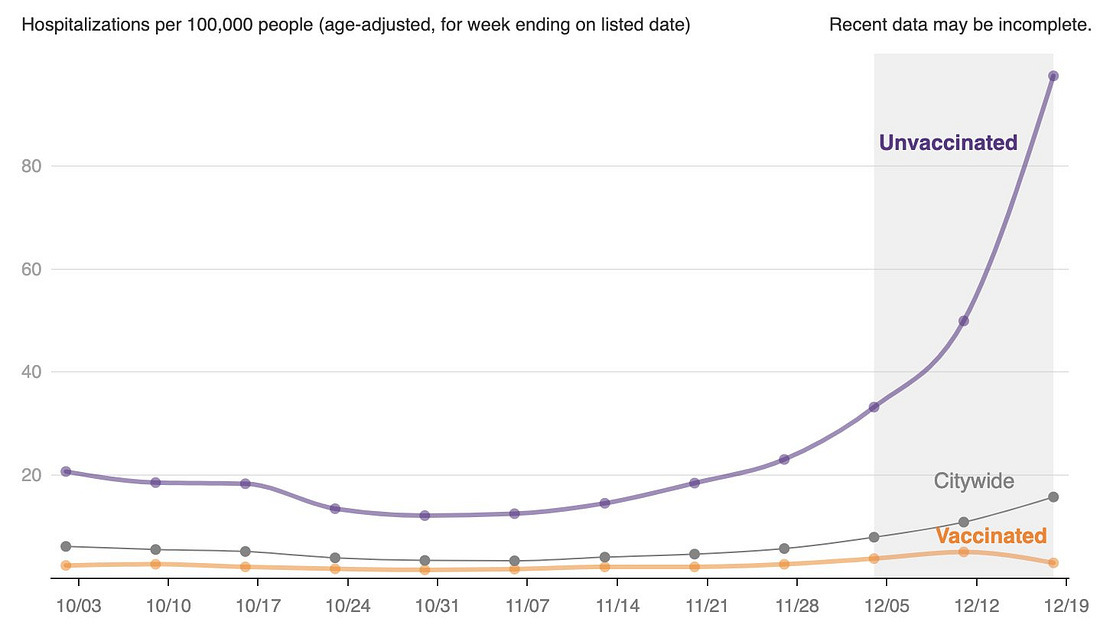
Test Sensitivity
The FDA uses the magic weasel words and claims rapid tests ‘may have reduced sensitivity’ to Omicron. Given the nature of what ‘may’ be true, such statements are always technically correct, and also always the ‘may’ mostly gets translated as ‘do’ or at least as ‘probably.’
I translate it that way too, because that’s the claim they’re effectively making. If you don’t have a very good reputation for your words having meaning, I’m not going to let you pull this transparent a weaseling that doesn’t deserve the dignify of being called a motte-and-bailey.
Abbot flat out denies the FDA’s claim of potential lowered test sensitivity, says their tests are as effective against Omicron as they were against previous variants.
This is at least some actual preliminary data suggesting that reduced sensitivity, but it has enough caveats and low enough sample size I’m not updating much on it.
Michael Mina, as designated fire-backer, fires back.
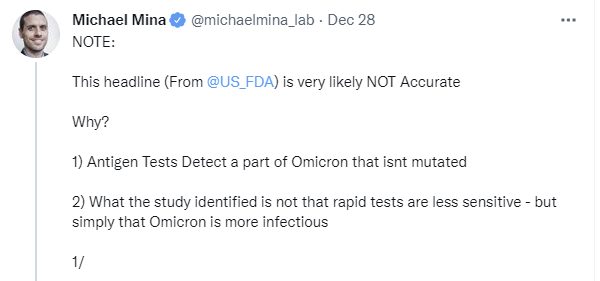
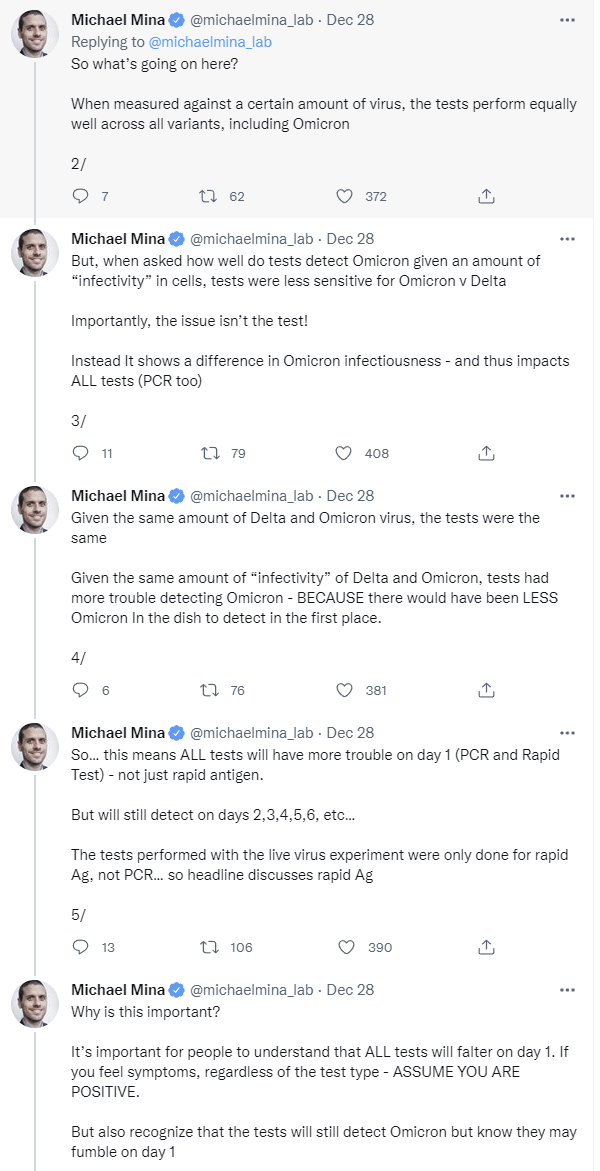
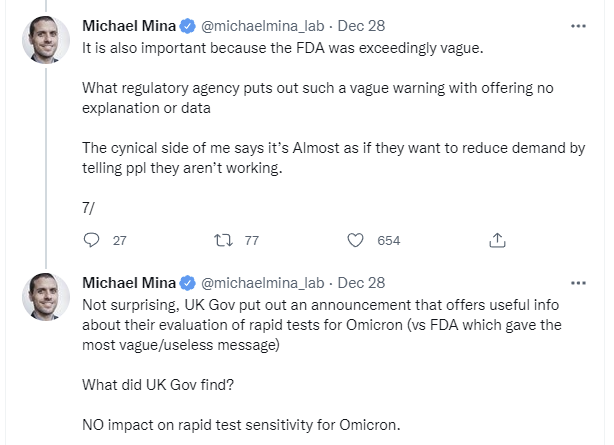


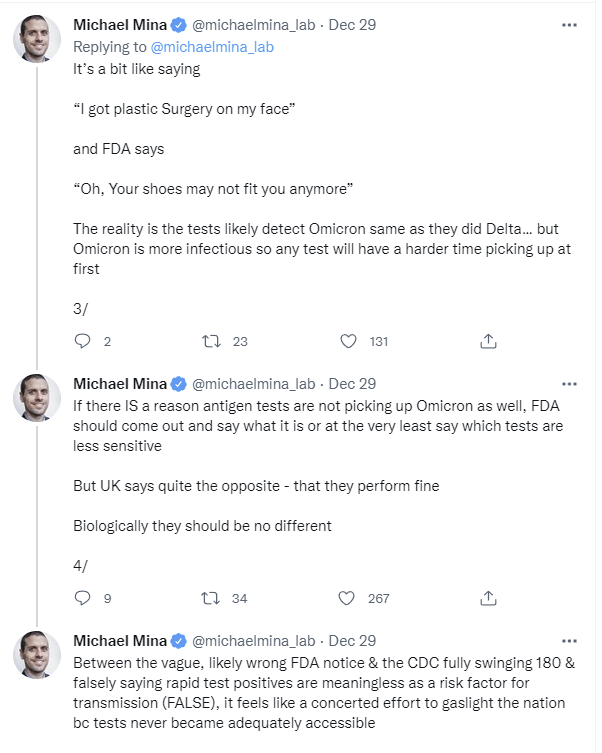
Mina’s prior seems right to me, but that interpretation doesn’t mean everything is fine. This still means that a rapid test is less effectively sensitive for knowing if you’re infectious. Which is what they’re for, so there’s still a problem whether or not the test is technically less sensitive. What matters is the practical utility of the test, and what it tells you.
I do agree that giving out vague ‘may be less effective’ warnings based on preliminary data is a good way to completely freak out a lot of people in an unhelpful way, without much in the way of upside.
Severity
Mouse model finds less pneumonia risk from Omicron.
Reaction
What are we doing about Omicron?

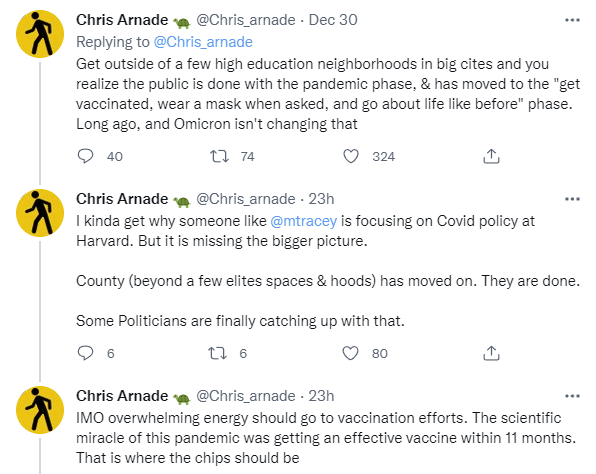
One can see this as the ‘less action’ camp versus the ‘more action’ camp, and there’s something to that. But it’s also important to notice that different actions make sense in different circumstances. The CDC reduced isolation requirements because conditions got worse, and it was necessary. That doesn’t contradict taking more precautions in other ways, nor does it require having an attitude of moving on.
Lack of government restrictions is good, but doesn’t mean business as usual, some places won’t be shrugging this off.

Three or four weeks with the promise of light after that seems highly survivable. That’s an accelerated timeline and it could easily take longer, but the restaurants should be fine not too long from now, if people use their heads.
The thing is, if you have already had and recovered from Omicron, restaurants are fully open for your business. About one in ten Londoners had the virus at one time this past week. All those people, or least the ones that are aware of it, can then fully exit their lockdowns. A month later, half the population can be partying like it’s 2019, on top of the ones who already didn’t much care, even if things haven’t fully died down yet.
The future’s so bright we may, in that future, require shades.




It’s a good question. Some of the confusion is that ‘collapse society’ is not a well-formed concept here. There are different levels of sacred value, and things we are and aren’t prepared to accept, as things get more dire, and trade-offs are being made. If the situation were different and worse, it would require different trade-offs.
Letting the original strain rage freely would not have collapsed society. It would have killed a lot of people and scarred pretty much everyone, but most of us would have survived and moved on. Forcing everyone with Omicron into extended isolation would shut down a lot of things over the next few weeks (with little upside to compensate) and if this included hospital staff it likely kills more people rather than less people. But we can survive those kinds of disruptions, it would be quite bad but the unthinkable now becomes the thinkable tomorrow.
But maybe that’s wrong? If we’d suffered a 4% death rate in the first half of 2020, what happens? What about if the supply chain problems hadn’t turned around?
The other perspective is that perhaps we really are a society on the brink of collapse, that can no longer be resilient in the face of threats, and we’re now dodging civilizational collapse on a rolling basis until at some point we fail to dodge it. In this model, the close calls we’ve had recently were actually remarkably close and could easily have gone in other ways.
In this case, I think we know the answer, because there was a lot of uncertainty about severity, and Bruno’s scenario was very much on the table until a week or two ago. It seems clear we were pretty committed to this course of action either way, and we’d have had to accept the consequences.
What about if we go to the next hypothetical? What if Omicron was more infectious by default and had also rendered the vaccines completely ineffective on all levels? At that point, I do think we have a real crisis where all the choices seem impossible, because we really can’t actually contain this thing under those conditions, but letting it rip would have unthinkable consequences and we’d be forced to try to slow things down, even though it would be a mistake – we wouldn’t be able to do enough slowing to have that much marginal effect.
At that point, the correct reaction really would be a ‘protect the vulnerable as best we can’ style reaction, while actively letting things go as quickly as possible otherwise to give that strategy a chance. I don’t think we’re capable of implementing that. But it’s important to note that we don’t know, and won’t until we are forced to run the experiment. The wartime generals are available if things get bad enough for the phone to ring.
Threads and Posts
29 December thread from Bob Wachter about what might happen over the next two months. It lays out the same scenario I’ve been increasingly expecting as the puzzle pieces have fallen into place, matching my non-logistical priors quite well.




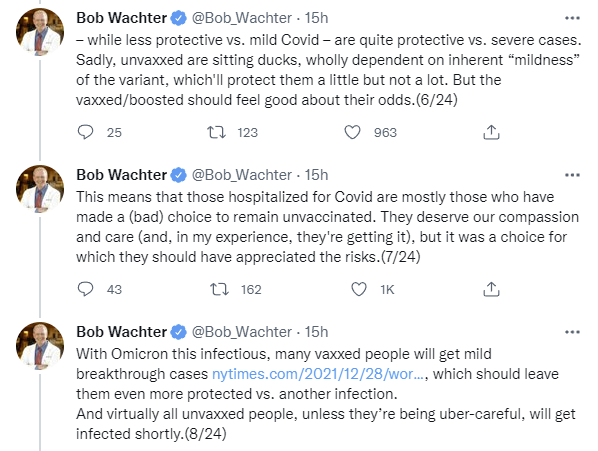
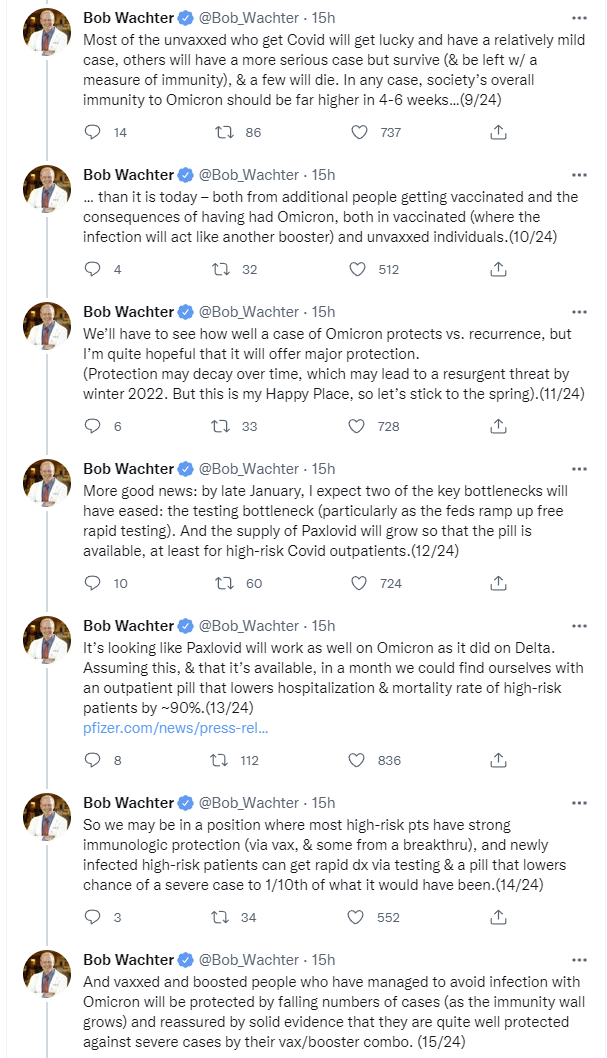

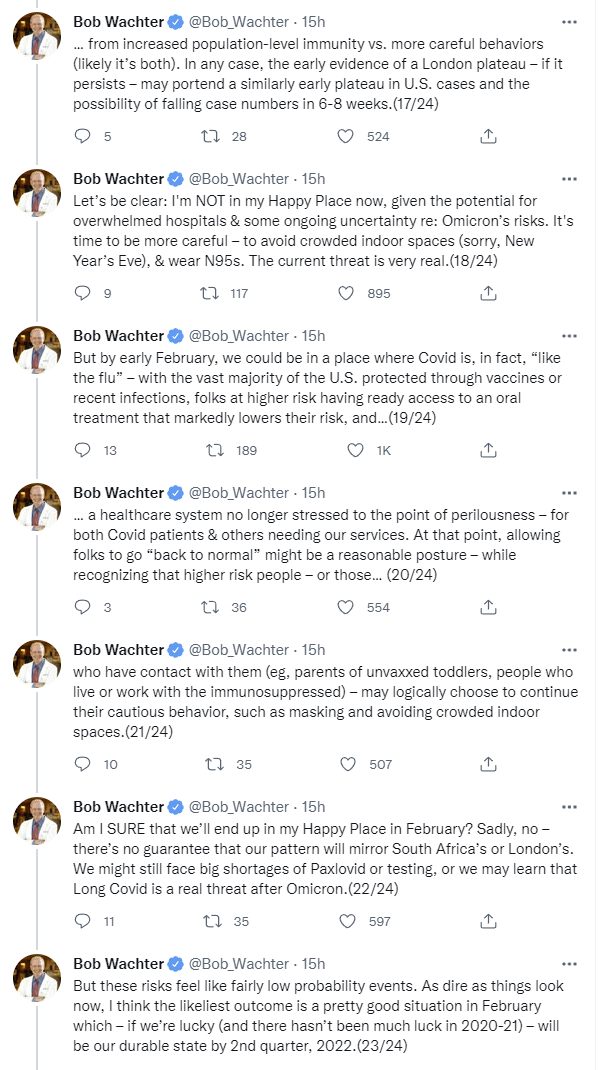

This seems like wishful thinking with regard to testing capacity, and also Paxlovid availability in the short-to-medium term (it’s also explicitly labeled wishful thinking, which is fully allowed.) My guess is London won’t peak until this coming week, but it’s impossible to tell because at such high levels you’re in the Fog of War and the official numbers aren’t helpful. Medicine and logistics are different magisteria.
But the rest is most of it and doing most of the work, and it checks out, so long as one reads February as the end of the month.
The current shortage in hospitals, WaPo reports (no paywall), is not equipment or beds but health care workers, because so many are sick and everyone is burnt out and stretched to the limit already after two years. Short term we’ve lowered isolation requirements, but there’s little we can do. Long term, the obvious solution is to expand supply by lowering the regulatory barriers that create artificial scarcity.
Kai looks at the question of how much of increased transmissibility is evasion, versus being more infectious (I’d add versus there being a shorter generation time, as well).


It’s worth noting that such official reports are often rather far behind, and a ‘no clear epidemiological demonstration’ type of statement from such a report means little.

Comparing households infected with the Omicron to Delta VOC, we found an 1.17 (95\%-CI: 0.99-1.38) times higher SAR for unvaccinated, 2.61 times (95\%-CI: 2.34-2.90) higher for fully vaccinated and 3.66 (95\%-CI: 2.65-5.05) times higher for booster-vaccinated individuals, demonstrating strong evidence of immune evasiveness of the Omicron VOC. Our findings confirm that the rapid spread of the Omicron VOC primarily can be ascribed to the immune evasiveness rather than an inherent increase in the basic transmissibility.
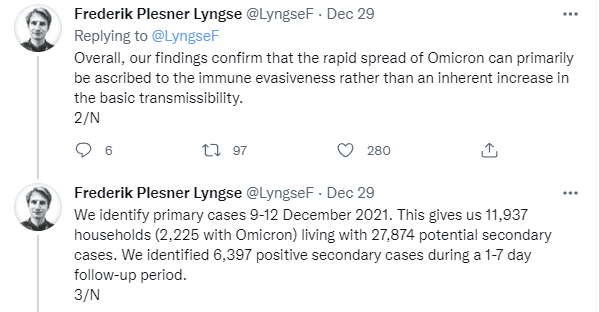

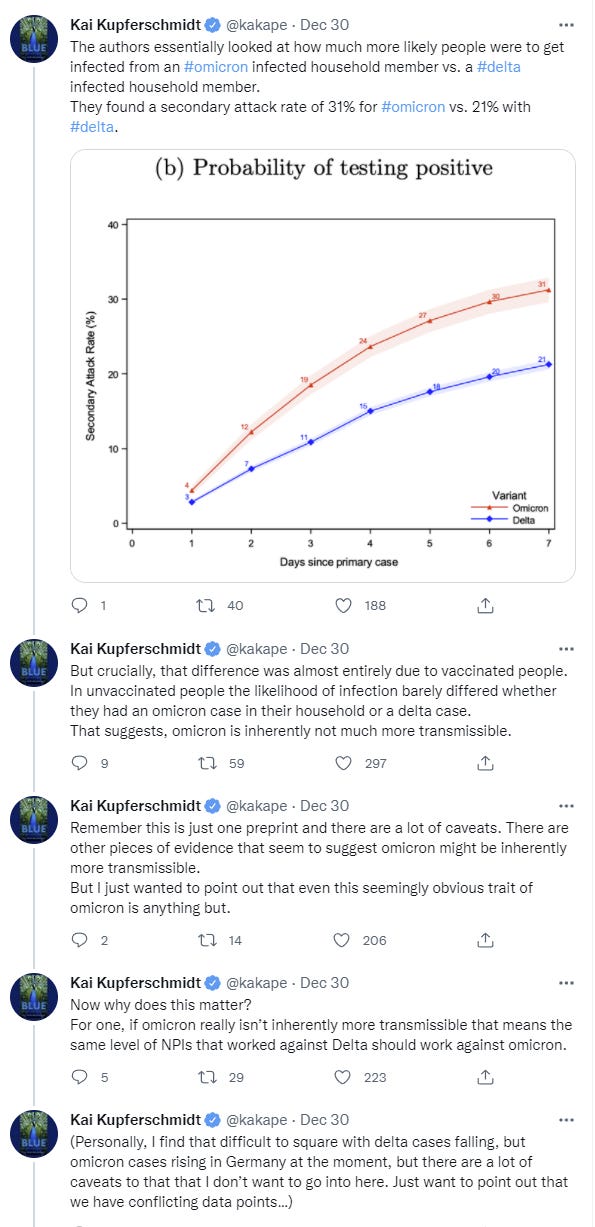
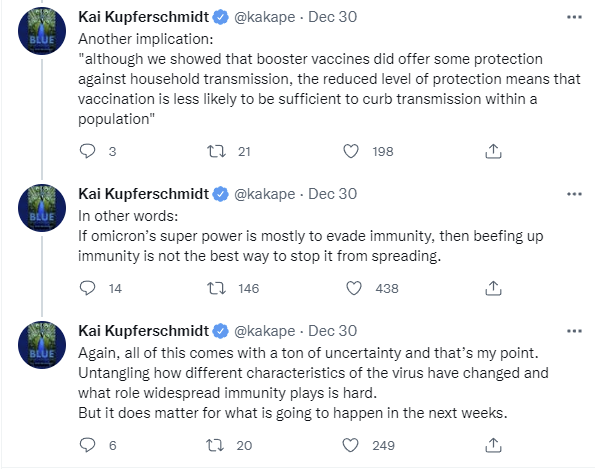
Here’s Peter Hanson’s interpretation of the same study.


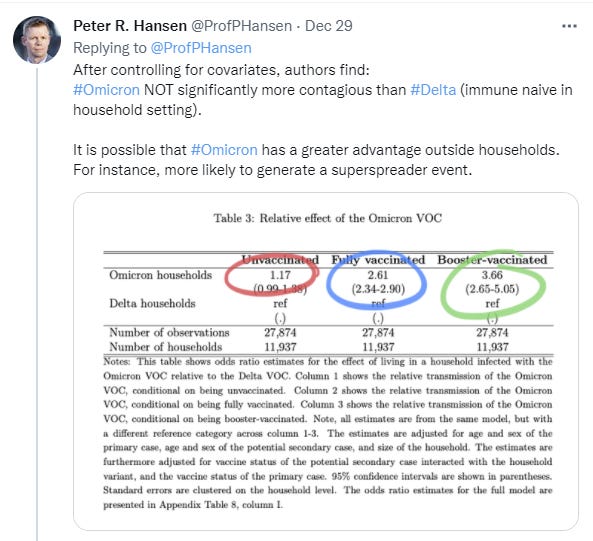
I do find this to be strong evidence that the transmission advantage is more heavily weighted towards immune evasion, which in turn suggests a lower generation time in order to make the whole picture work.
I’m updating in that direction based on the study, although the 17% inherent increase here (whether or not it’s ‘significant’) is still a substantial push on its own given we were already being pushed to the limit, I take the 17% seriously as far as it goes, and I agree with Hansen that in other contexts the edge could easily be far bigger.
Focus on vaccination still seems like the best approach. I agree that it’s less good at ‘stopping it from spreading’ but that’s no longer on the table. Western countries could not have contained Delta without vaccinations, so ‘the same NPIs that contained Delta’ are doubly not an option. We couldn’t do again what we did before even if it would work, and even if we did it again somehow anyway, they wouldn’t work.
This helps clarify what is happening and project things forward, but in the central case it changes things very little.
Other Omicron News
If you want the ‘oh no everything is terrible we are doomed’ perspective in relatively credible form, my attention was just drawn to Tatiana Prowell, who is good for an endless stream of terrible data points if that’s something you are interested in. Things definitely aren’t going to be fun in many places over January.
I didn’t find the ‘look for all the scariest possible data points’ data stream to be especially more or less scary than I expected it to be, so I didn’t update much, but it’s good to have it in one’s mix, and to know that some people are making predictions like this:

I don’t think that’s right, but if there are key supplies like prescriptions you need over January, yes, definitely get them now. Make sure you can weather some supply chain disruptions in case they happen, just in case. Better to play it safe, 10% is not 0%.
Omicron seems to have switched cell entry methods. Paper (pre-print).
Latest superspreader event case study, 21 of 33 boosted people infected. I’m primarily interested to look at generation times, since superspreader events are by definition abnormal and we’re not going to learn much new about infectiousness from outliers at this point.
If we assume that the exposure to SARS-CoV-2 was on the evening of the gathering, the incubation period was short, ranging from 2 to 6 days, with a mean incubation period of 3.24 days (95% CI 2.87- 3.60). Time to resolution of symptoms varied, and at the end of follow-up, five individuals still reported symptoms, while the rest reported symptoms lasting 1 to 9 days.

A ‘near miss’ with severe symptoms is disappointing, but in the most important sense this is still another 0 for 21.
We now know exactly what was up with the CDC nowcast. It was obvious nonsense. I hoped it was mostly harmless obvious nonsense, but perhaps not.
I’d also note that if you have the monoclonal antibodies, even if you think they’re only 27% to work, wouldn’t you use them anyway? I’m pretty sure they’d still pass the cost-benefit test, and next week they’re going to be even less likely to work.
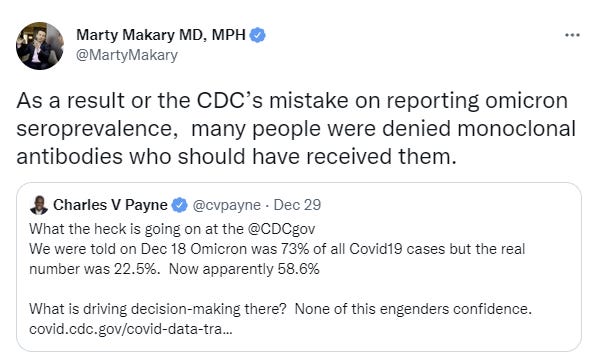
Not Omicron so holding off on the full discussion but if you haven’t seen the thread discussing an attempt to publish a paper with the CDC, you should go ahead and read it now, in a ‘offered without comment’ kind of way, in the meantime.
Probability Updates
I was asked in a comment whether I am measuring my calibration. The answer is that I am not, and I consider that but a small part of prediction evaluation, but if someone else wants to do that (without me anchoring you on how to do that measurement) by all means go ahead.
Chance that Omicron has a 100% or bigger transmission advantage in practice versus Delta: 65% → 70% (EDIT: -> 60%)
The new study says 161% in vaccinated people, 266% in the boosted, 17% in the unvaccinated. I originally thought that was more than 100%, but I did the math wrong and it’s not, so I should have adjusted the other way, but one does not edit prediction probabilities cause that’s cheating.
Chance that Omicron is importantly (25%+ in the same person) less virulent than Delta: 80% → 85%.
Chance that Omicron is vastly (75%+ in the same person) less virulent than Delta: 20% → 20%.
Didn’t get much new evidence and thus not much additional clarity, but if there wasn’t at least the 25% level we’d expect to see trouble in ways we are not seeing, so we can get more confident there.
Chance we will be getting boosters modified for Omicron within 6 months of our previous booster shot: 25% → 20%.
Israel floated a fourth shot when it still mattered and pulled back. On reflection I see it as less likely that, in a world where Omicron is rapidly declining, we’ll tell people to get fourth shots this quickly, especially with severe disease protections holding.
Chance we are broadly looking at a future crisis situation with widely overwhelmed American hospitals, new large American lockdowns and things like that: 15% → 10%.
The math seems to indicate that the major city hospitals, under large vaccination rates with good capacity, will hold. If that’s true, even with the rural ones already in trouble now, I don’t see a way for this to be a crisis that makes this true, and everyone is moving towards a ‘life must go on’ position. I’m not ready to call this quite yet, panic can still be a thing, but Washington DC is being hit very hard and mostly not flinching. In another week we can likely mostly write this off, except in the scenarios where we suddenly can’t.
Generation time (serial interval) of Omicron is 3.5 days or less: 85% → 85%.
Didn’t learn much, the superspreader event wasn’t that helpful.

Heh. Mine is John Gorka’s Morningside. Given the lyrics, the appeal to someone at my later stage in life should be obvious. Also, he looks at the camera and grins like he’s letting you in on an inside joke… which is exactly what he’s doing.
Though, now that you remind me of Jewel, Hands is pretty awesome, too, for living through difficult times.
“I still don’t know how to properly translate a 16% positive rate into an expected percentage of cases being missed”
I don’t either, but I’ve had some reasonable results by compensating with new infections = new cases * (1 + 300*pos_rate)^0.4. Plugging in 0.16 gives a factor 4.7; adjust downward if rapid tests are the norm and positive cases are counted by PCR as verification (as this raises the positive rate without leading to missed cases). You can check https://danielssim.github.io/site/covid_models/corona_models.html for a writeup of the reasoning and a few countries plotted here.
(I feel conflicted posting this here as I expect you to do better than a simplified formula by including actual information in a mental model. The country-level plots are pretty slow to update and there’s little to learn from them on the current state of things. Please feel free to ignore or delete this comment if you like to)
Quebec has imposed a 10pm curfew, shut all events/gatherings of any kind, ordered everything to be closed on Sundays, limited to gatherings to a max of one household.
Every other part of Canada, while not on Quebec’s level, is substantially more restricted than any part of the USA, irrespective of liberal or conservative provincial governments.
It is unclear how much of this reaction derives from a practical calculation based on Canada’s reduced hospital capacity vs a difference in values.
It is also worth noting that booster shots are still illegal for many adults in Canada. My mom and my uncle, both over 65 and living in BC, had to wait for an invitation to book appointment which didn’t come until a week or two after 6 months from their second shot.
Quebec, which by current reports is risking overwhelmed hospitals, will begin to expand booster eligibility to under 60 in the new year. https://montreal.ctvnews.ca/mobile/quebec-expanding-covid-19-booster-shots-asking-certain-infected-health-workers-to-keep-working-1.5721049
I feel grateful I live in Alberta. The government here dropped the eligibility from 50 to 18 the week before Christmas, but more importantly reduced the interval between second shot and booster to five months, from six. Without this step, the announcement would have been stunted by a large number being still ineligible
And it’s worth mentioning that Paxlovid is still illegal in Canada, despite it being a drug that does EXACTLY what we need, keep people out of hospital.
Oddly from my perspective, I’m a bit less pessimistic on this than possibly you are.
If Omicron had been much more virulent (as measured by hospitalization & death rates on vaxed/boosted population), it seems to me that we’d be in approximately the situation of Spring 2020: anxiously awaiting a vaccine, in this case omicron-specific.
Both Pfizer and Moderna are in trials for variant vaccines, and the FDA has said they’d treat those as somewhat like the annual flu vaccine: an update, not a full in-depth review. We have no technical reason to believe that a strain-specific mRNA vaccine would fail to work better on that strain than the classic mRNA vaccine.
The positives that would be on our side (as you note Wachter pointed out, in part):
(1) omicron/delta-specific vaccines, already under development, and would be scheduled for rapid review
(2) paxlovid increasingly available in situ
(3) testing increasingly available, perhaps a looser leash on new test approvals at FDA
The negatives that might gum up the works:
(1) supply chain problems (all 3 of the positives above depend on regrettably complicated supply chains)
(2) essential workers, especially healthcare and food/utility pipleines (electricity, gas, water, sewage, gasoline)
(3) panic and general insurrection around vaccine resistance (we’ve shown altogether too much of this already, so another bad wave might set it off again?).
On the whole, I’m hopeful that if Omicron had turned out much worse, we’d lock down and get strain-specific vaccines out ASAP. My nightmare is that it would bring out more of the worst in us.
My basic model is that with this particular timing the logistics wouldn’t have lined up. It’s a good question what would make them brave enough to update the booster and not require tests, but even then they need substantial time.
Even if a lockdown wouldn’t have bought R to be less than 1, if it would have bought doublings to say once every 10 days and we had vaccinations going in 120 days – fairly reasonable, we would only have 12 doublings, which would mean most of the population wouldn’t have been infected.
Plus the theoretical “bring R to 1.4 with lockdowns, <50% of the population, preferably more amongst the more-cheaty, gets infected, vaccinate the other 50%, remove lockdown" nuclear option.
Remember that boosters only take 1 week to have effect.
What if we come out of Omicron to see… Atlas Shrugged? This is what the antivaxx are saying.
Team Dagny, all the way.
I’m half trolling, the standoff and signalling over policies such as the leftover COVID responses and the way to economic recovery will be tense, but solve out in the medium-term.
If Omicron’s superpower is immune evasion, why doesn’t this translate into hospitalizations as well? Seems like we’re seeing two different phenomenon cited in #11 here.
I think the idea is that Omicron evades (most) antibodies but not T cells.
Latest new case rate numbers out of Alberta, since I have them handy, through December 28
December 28
Vaccinated: 72.25/100k
Unvaccinated: 47.06/100k
vs December 22
Vaccinated: 40.37/100k
Unvaccinated: 33.55/100k
vs December 5
Vaccinated: 6.05/100k
Unvaccinated: 21.84/100k
Case rate in the two largest urban centres is 3.75x higher than areas outside those centres over the past 7 days. ~60% of the unvaccinated population of the province is in those urban centres and getting full exposure to Omicron, but 40% remain underexposed. I still think that case growth in the unvaccinated population is a bit suspiciously low, but it appears this population now has its shoes on at least and its case growth is starting to resemble exponentialized. Urban/rural divide looks like it explains most of the discrepancy, but it’s having to do a lot of explaining. It’s really hard to tease out any meaningful advantage for vaccination anyway.
I should clarify or at least update my personal view on Omicron severity. I am fairly optimistic it will prove less severe in the unvaccinated who lack acquired immunity. The data is certainly trending that way and I am positively giddy at the prospect. I was a bit concerned the optimism might be a bit premature, given how slow the case rate growth was in the unvaccinated population where I was tracking it most closely. No significant growth in severe outcomes when there is little to no significant case growth yet in the unvaccinated population felt a bit like a chicken counting exercise.
I want to see +10 days hospitalization numbers after case rate has at least doubled in the unvaccinated population. Will hospitalizations double in lockstep with that, or will it be less? How much lower does the unvaccinated hospitalization rate for Omicron have to be, compared to Delta, in order to safely conclude Omicron is less virulent in those who remain immunologically naive?
Solving that question is complicated. The trickiest variable for solving it is the protection previous infection provides against Omicron in the unvaccinated. Will we see an equal rate of symptomatic infections in the previously infected unvaccinated as we see in the vaccinated? If yes, then we have perhaps just doubled the unvaccinated population that’s susceptible to symptomatic infection but not hospitalization. This means that Omicron could be exactly as virulent as Delta but only put the unvaccinated in hospital at half the rate of Delta.
(For the sake of a back of the napkin argument, 50% previous infection rate in the unvaccinated is probably not a terrible estimate in this particular population. Alberta is nearing 10% of the population having tested positive, and only a fraction over 20% remain unvaccinated. I am assuming a good chunk of that almost-10% who have tested positive are in the unvaccinated cohort, and a good chunk of cases that ultimately went undetected are probably in the unvaccinated cohort as well. It is probably not completely crazy to assume that up to 50% of the unvaccinated population has naturally acquired immunity.)
If naturally acquired immunity is stronger than vaccination in preventing symptomatic Omicron infection – for the sake of argument, equivalent to what it was against Delta – then we can assume the detected unvaccinated Omicron cases are in the exact same immunity-lacking population where we were detecting Delta among the unvaccinated. (This would allow for discrepancy in the vaccinated/unvaccinated case rate too…) In that scenario, hospitalization rate in the unvaccinated should much more closely match what we saw with Delta if Omicron were as virulent.
I really don’t know which of those two worlds the real world is closer to.
If prior infection is exactly as effective (no more/no less) against Omicron as vaccination, then the hospitalization rate in the unvaccinated would have to near 50% (or even lower) the rate we saw with Delta in order to attribute some of that reduction to lower virulence. Anything much short of 50% reduction in the unvaccinated hospitalization rate compared to Delta will be very hard to attribute to anything other than acquired immunity/larger pool of unvaccinated susceptible to symptomatic infection but not hospitalization. If prior infection is exactly as effective against Omicron as it was with Delta, then any reduction at all in the Omicron rate of hospitalization in the unvaccinated compared to Delta is most likely attributable to lower virulence.
Ultimately, I think the upshot is that either scenario is probably very good news. Either we have already effectively reached a level of population immunity that even with Delta-equivalent virulence it’s very hard for the health care system to be threatened, or we have the opportunity to top up population level immunity to that degree with a less dangerous variant that is virtually inescapable. We will be vaccinated by Omicron whether we want to be or not. Either way I just don’t see there being any need to remain on pandemic footing after the Omicron wave crests and recedes. The fight will be on to make sure public policy reflects that.
I have asked and asked various folks but can’t find a decent answer to the question of what is getting people into hospital with hospital if they are (seemingly) not in need of oxygen, aren’t (generally) going into ICU and (generally) aren’t dying. I don’t understand how it’s necessary to cram hospitals full of people who seem ill but really not *that* ill. Can’t they convalesce at home? In contrast, here in the UK you had to be blue at the gills and/or practically dead to get admitted during the first wave. My daughter, then eighteen months old, had a big meningitis scare on like day three of the first British lockdown. Getting them to agree to check her out at the hospital less than two miles away was a stiff task. She was all clear, thank you for asking. If the hospitals are understaffed and overwhelmed why don’t they just stiffen admission criteria? At least with my daughter lack of knowledge of covid was an excuse. But now, what on earth are you doing being put in hospital unless you’re really, really I’ll?
I think the deal is that people end up in hospital for reasons other than COVID, and then coincidentally test positive for COVID, and some/many jurisdictions count these cases as “people in hospital with COVID”, muddying up hospitalization rate statistics. A big wave of a milder variant can have a lot of people in hospital “with” COVID simply because lots of people are infected, but few actually there for COVID-related reasons. It’s often not clear which jurisdictions are doing this and which aren’t.
It’s the with/for distinction. Generally people don’t come in for Covid if they don’t need supplemental oxygen. Or if they do, they’re there just long enough to get a chest X ray and then go.
First two weeks of January I’ve found to always be the highest bed pressure parts of the year in general, due to the amount of elderly care admissions. It also probably doesn’t take a *bad* case of any viral illness to knock a frail older person’s functional status below the level needed to get by at home.
Zvi, what would you say is the probability of the proposition “Long Covid is about as common and severe as the Feigl-Ding-type alarmists think it is”?
20%? 10%?
The true alarmists? Forgetaboutit. But I’d need to know exactly what I’m up against before knowing what I’d be willing to sell down to.
Back at work tonight in my provincial city;
Looks like Covid ICU numbers have doubled since Thursday, though from a low base (which is to say it would likely be possible to double twice more before having to repurpose more general use intensive care beds for Covid purposes).
The respiratory covid ward is significantly more “for Covid” compared to four days ago. I’d expect this to change slower than critical care admissions, as the type of patient who comes in with-covid is often the kind that spends forever sat there awaiting placement. Beds and equipment wise there’s enough space for a lot more acute covid patients to come in, though there’s a finite supply of respiratory-trained nurses which has somewhat been hit by absences, and there’s very little feasible way to expand capacity in the short term.
With-covid capacity similarly has room to expand, though obviously that might displace other stuff. General medicine (mostly elderly care) always tends to displace other things in January, though, this isn’t new. I remember four years ago or so, fully half of the Cardiac Surgery ward was filled with elderly care type patients.
It’s definitely worse right now than it was at any point since the summer, but it’s not close to January 2021 covid-wise and I don’t really see it getting there.
Zvi, is there actually any sense in purchasing at-home rapid tests? They seem to often give false positive and false negative results, plus you can easily get infected with omicron the next day.
Given that I’m double-vaccinated and generally avoiding contact with people till April 2022, if I notice any symptoms typical for omicron, I can likely conclude that’s it and not some kind of cold/flu with a much lower infection rate. I can then hope that the combination of vaccination, milder variant, and supplementation will ensure a mild course of Covid-19, but if things become concerning (stronger symptoms after 4-5 days, SpO2 below 92%), I can then start using Paxlovid and/or fluvoxamine.
Does this approach make sense?
They do provide reasonable bits of info on whether you’re infectious, and can alert you on when to seek PCR for Paxlovid if you could have access. I do think they’re still worth it if you have symptoms, plus they make other people feel more comfortable.
Thank you. I live in a small flat with my friends, so if one of us gets infected, then we’ll all be near-certainly infected. Does the rest of the comment make sense if I can get Paxlovid without a PCR, or can’t get it at all and have to resort to fluvoxamine?
I would be pretty surprised if you can get Paxlovid without a PCR. It’s not easy to get, supply is very limited.
Well I guess Canada is closing down to protect hospital capacity. At least the largest jurisdictions. Predicting 100s of thousands of new cases a day, and a 1% hospitalization rate. With an >80% vaccination rate.
Here’s some interesting graphs, although I may be misinterpreting these, as my BA is in economics :) Trevor Bedford at Fred Hutch is showing Seattle area reproduction of Omicron crashing, but delat rising again, at Rt of 2.4. https://github.com/blab/rt-from-frequency-dynamics/tree/e6121292ec1e767ce18fe79c9fa85c9c39f69fbe/results/sgtf-king-county
Trevor is top notch and I trust him as much as anyone, but I simply don’t believe the data, something got messed up somewhere.
I’m WAY out of my league here, so there is a good chance I’m wrong. Looking at the Variant-specific Rt graph and thinking of Rt as acceleration (or is it accelerations’ derivative and the rate of acceleration change??), then it predicts a near term peak in O cases, but also shows D growing relatively rapidly, but from its now much lower base. And the input data is 4 days old, plus there is a huge amount of at-home testing now that isn’t going into the model. And the spike in O cases has been huge, and in Seattle, even with the holidays, people went back into caution mode and so there is reason to think that transmission rates went down due to behavior in the past weeks (crowds in restaurants went down, people canceled parties, plus we had a week of snow on the ground and folks stayed home) And I wouldn’t classify this as “good news” (actually, its not news – it’s his model’s output). O has a shorter incubation period, and the actual caseload may be 2X or 3X (???) above reported PCR tests. I’m guessing there is a non-zero chance that hospitalizations go thru the roof over the next two weeks. The other graph that got me thinking is Norway (which is always a special case! and small population. and isn’t geographically centralized – no one wants to be in Oslo). It shows O peaking as a % of of infections, but D coming back (as a %, not absolute numbers). https://github.com/blab/rt-from-frequency-dynamics/tree/master/results/omicron-countries
At least we’re not claiming to be able to predict interest rates! Although isn’t that supposed to be OUR job? :)
Pingback: Omicron and the Return to Normalcy – Smart Again